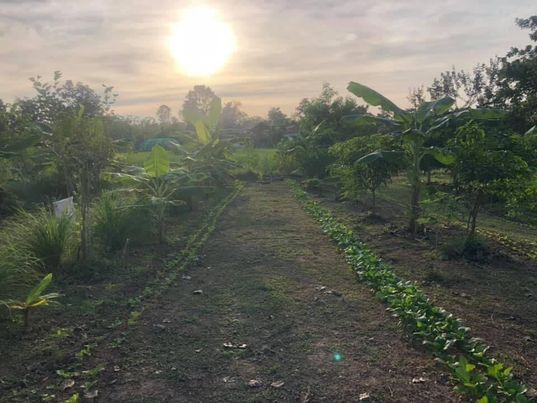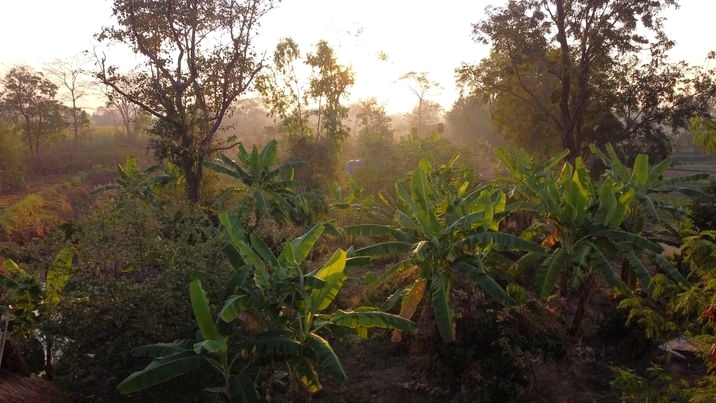No one fertilizes or irrigates a forest… The forest is self-sustaining. If you are able to recreate an edible forest, your main effort will simply be harvesting its fruits.
If you’ve ever wandered along the back roads of a developing tropical country, you know that many locals grow a large portion of their own food. You may also have noticed that their gardens are not made up entirely of small annual vegetables planted in neat rows like ours. They are usually plantings of edible trees, shrubs, vines, and ground covers that blend effortlessly, as if Mother Nature herself designed the garden. These are literally edible forests, forest gardens…
Beneath these various names lies one single cultivated ecosystem. By combining the principles of permaculture and agroforestry, it allows any piece of land, regardless of size, to be transformed into a lush, sustainable edible garden.

Forest gardening has been practiced for millennia in many tropical regions, but it is also possible in more temperate climates…
Edible forests have also played a central role in the permaculture movement, an approach that differs from modern agricultural systems by mimicking natural ecosystems.
Here’s a brief summary of the concept:
🌳 AGROFORESTRY refers to practices that combine trees, crops, and sometimes animals on the same plot, seeking complementarity between the different elements. For example, trees bring water and minerals up from deep soils, benefiting surface crops. Additionally, 40% of tree biomass returns to the soil each year, continuously enriching it.
🌳 PERMACULTURE, when applied to gardens and vegetable plots, aims to imitate nature to cultivate abundant harvests. In practice, it involves creating systems that possess the same diversity and resilience characteristics as natural ecosystems.
🌳 Within this approach, a forest garden is an edible garden that mimics the structure and diversity of a natural forest. It includes different layers of vegetation (STRATA): food trees, fruit trees, shrubs, perennial herbs, aromatic plants, root vegetables, edible vines, and even mushrooms, all carefully combined. Sometimes, a water feature is added to increase the system’s complexity. In our case, we have also installed a vegetable garden and beehives, hoping to enhance pollination.

Why an Edible Forest?
They are like the ultimate organic garden. Does a forest need plowing, weeding, fertilizing, or irrigation? No — and that’s the point.
Because it mainly consists of perennial crops, plowing is unnecessary. Avoiding tillage preserves the natural soil structure, prevents the loss of topsoil, and allows all the tiny soil microbes and creatures to do their work: recycling nutrients and maintaining fertility. The deep roots of trees and shrubs make them much more drought-tolerant than annual vegetables, and they shade the smaller plants below, keeping everything lush and moist in a self-sustaining system — in other words, a highly sustainable system.

How to Build a Forest Garden?
The first step in establishing a food forest is choosing your plants. The tallest plants will reach the sunlight, so fruit trees and shrubs are the most common. Smaller plants generally need to be more shade-tolerant, as they will grow in the understory. However, you can leave sunny spots here and there, like small forest clearings, to accommodate species that require more light (see Step 3 for a tip on making the most of available sunlight).
THE CANOPY: This layer is mainly for large nut trees that require full sun throughout the day, such as pecans, walnuts, and chestnuts. We also use teak.
UNDER THE OLDER TREES: This layer is for smaller nut trees, like hazelnuts, and the majority of fruit trees. Shade-tolerant fruit trees include species such as mulberry, papaya, mango, and vines like grapes, kiwis, and passion fruit. There are also many lesser-known species to consider, some quite shade-tolerant, such as chayote (a perennial squash) and peanut (perennial root).
HERBACEOUS PLANTS: This category includes not only plants commonly considered herbs—such as rosemary, thyme, oregano, lavender, mint, and sage, which are some of the best perennial culinary herbs for your forest garden—but is also a catch-all for all leafy plants that die back in winter and regrow from their roots in spring. This layer includes perennial vegetables, such as artichokes, rhubarb, asparagus, as well as squashes and Thai eggplants.
GROUND COVERS: These are perennial plants that spread horizontally to cover the ground. Edible examples include strawberries, sorrel, nasturtiums, as well as watermelon and melon.
THE RHIZOSPHERE: This refers to root crops. Calling it a separate layer can be misleading, since the above-ground part of a root crop may be a vine, shrub, ground cover, or herb. However, this concept is a reminder to consider the production of edible roots in your forest garden.

But beware!
Choosing the species to plant in your forest garden requires thought and knowledge of guilds. In permaculture, guilds are plant associations that cooperate to help each other thrive. Some plants attract pollinators, others fix nitrogen, and some repel harmful insects. Their different growth forms prevent them from competing with each other. Guilds are a combination of forms and functions, based on natural cohabitation.
By observing nature, we find natural plant associations that have chosen to grow together. In permaculture, we aim to recreate these natural guilds. The study and identification of these guilds is called phytosociology.
In an edible forest, for diverse, abundant, and sustainable gardens, it’s best to take inspiration from nature. Unlike traditional agriculture, which promotes monoculture, the natural model teaches us the benefits of multi-layered, dense, diverse planting, composed of plants that support and help each other.
Guilds are key to designing forest gardens and are what provide their main advantages: resilience, abundance, and biodiversity.
To make a guild work, start by ensuring that the plants you group together fulfill at least three different functions among the following:
Nitrogen fixers
Plants that bring up mineral nutrients
Soil-structuring plants that loosen the soil with their roots
Aerial-structuring plants that provide shade, wind protection, or support for other plants
Attractive plants that draw pollinators or predators, thereby protecting neighboring plants
Repellent plants that deter pests and unwanted visitors

Conclusion
Agroforestry can offer immense benefits for both the environment and the farmer. For farmers, the ability to maintain some control over their land and production in the face of climate change means that agroforestry could be very promising for the agricultural sector.
From an environmental perspective, agroforestry can help prevent soil erosion, while also improving water retention and enhancing soil fertility. This provides a solution for areas where rainfall is irregular or may become so due to climate change. Additionally, dense tree plantings help absorb CO₂ and regulate local temperatures.
In summary, the goals of a forest garden are to create a sustainable, diverse, and dense ecosystem, resilient enough to withstand disturbances such as climate change, while providing abundant harvests.
Share this:
Articles similaires
Discover more from Woofing in Thailand
Subscribe to get the latest posts sent to your email.

